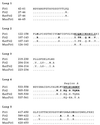A 13-amino-acid Pit1-specific loop 4 sequence confers feline leukemia virus subgroup B receptor function upon Pit2
- PMID: 10684313
- PMCID: PMC111787
- DOI: 10.1128/jvi.74.6.2926-2929.2000
A 13-amino-acid Pit1-specific loop 4 sequence confers feline leukemia virus subgroup B receptor function upon Pit2
Abstract
Feline leukemia virus subgroup B (FeLV-B) and gibbon ape leukemia virus (GALV) utilize the human protein Pit1 but not the related protein, Pit2, as receptor. A stretch of 9 amino acids, named region A, was identified in the putative fourth extracellular loop of Pit1 (residues 550 through 558) as critical for FeLV-B and GALV receptor function. However, the presence of Pit1 region A did not confer receptor function for FeLV-B upon Pit2, while it did so for GALV. We have here shown that the presence of two Pit1-specific loop 4 residues (tyrosine 546 and valine 548) in addition to Pit1 region A is sufficient to make Pit2 an efficient FeLV-B receptor; that is, a stretch of 13 amino acids encompassing all loop 4 amino acid differences between Pit1 and Pit2 comprises a C-terminal determinant for FeLV-B receptor function. Thus, the same limited receptor region is sufficient to confer receptor function for both viruses upon Pit2.
Figures

Similar articles
-
Variable regions A and B in the envelope glycoproteins of feline leukemia virus subgroup B and amphotropic murine leukemia virus interact with discrete receptor domains.J Virol. 1997 Dec;71(12):9383-91. doi: 10.1128/JVI.71.12.9383-9391.1997. J Virol. 1997. PMID: 9371598 Free PMC article.
-
Identification of envelope determinants of feline leukemia virus subgroup B that permit infection and gene transfer to cells expressing human Pit1 or Pit2.J Virol. 2001 Aug;75(15):6841-9. doi: 10.1128/JVI.75.15.6841-6849.2001. J Virol. 2001. PMID: 11435563 Free PMC article.
-
Three distinct envelope domains, variably present in subgroup B feline leukemia virus recombinants, mediate Pit1 and Pit2 receptor recognition.J Virol. 1997 Nov;71(11):8116-23. doi: 10.1128/JVI.71.11.8116-8123.1997. J Virol. 1997. PMID: 9343161 Free PMC article.
-
Single amino acid insertion in loop 4 confers amphotropic murine leukemia virus receptor function upon murine Pit1.J Virol. 1998 May;72(5):4524-7. doi: 10.1128/JVI.72.5.4524-4527.1998. J Virol. 1998. PMID: 9557753 Free PMC article.
-
Unearthing FLVCR1a: tracing the path to a vital cellular transporter.Cell Mol Life Sci. 2024 Apr 6;81(1):166. doi: 10.1007/s00018-024-05205-3. Cell Mol Life Sci. 2024. PMID: 38581583 Free PMC article. Review.
Cited by
-
Mapping of the minimal inorganic phosphate transporting unit of human PiT2 suggests a structure universal to PiT-related proteins from all kingdoms of life.BMC Biochem. 2011 May 17;12:21. doi: 10.1186/1471-2091-12-21. BMC Biochem. 2011. PMID: 21586110 Free PMC article.
-
Transmembrane topology of PiT-2, a phosphate transporter-retrovirus receptor.J Virol. 2001 Jun;75(12):5584-92. doi: 10.1128/JVI.75.12.5584-5592.2001. J Virol. 2001. PMID: 11356966 Free PMC article.
-
The central half of Pit2 is not required for its function as a retroviral receptor.J Virol. 2004 Sep;78(17):9564-7. doi: 10.1128/JVI.78.17.9564-9567.2004. J Virol. 2004. PMID: 15308749 Free PMC article.
-
Identification of a novel function of PiT1 critical for cell proliferation and independent of its phosphate transport activity.J Biol Chem. 2009 Nov 6;284(45):31363-74. doi: 10.1074/jbc.M109.053132. Epub 2009 Sep 2. J Biol Chem. 2009. PMID: 19726692 Free PMC article.
-
Genetic Engineering and Enrichment of Human NK Cells for CAR-Enhanced Immunotherapy of Hematological Malignancies.Front Immunol. 2022 Apr 7;13:847008. doi: 10.3389/fimmu.2022.847008. eCollection 2022. Front Immunol. 2022. PMID: 35464442 Free PMC article.
References
Publication types
MeSH terms
Substances
LinkOut - more resources
Full Text Sources
Research Materials
Miscellaneous

